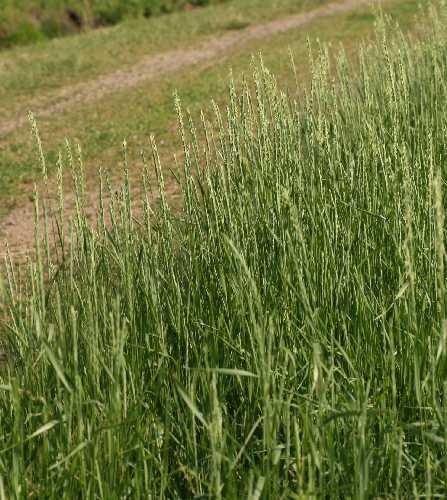Elymus repens
Quackgrass
Synonyms: Agropyron repens, Elytrigia repens, Elytigia vaillantiana, Triticum repens, Triticum vaillantiana
Class: Liliopsida
Order: Cyperales
Family: Poaceae

Photographer: Josh Sulman
Source: http://wisplants.uwsp.edu/
Description
Elymus repens is a perennial grass that grows by horizontal creeping stems (rhizomes). Quackgrass stands can reach almost 4 feet in height and grows in clumps. Stems are round but the leaves are flat and about 1 ½ to 12 inches long and 4/5 to 5 ½ inches wide. The upper leaf surface is hairy or waxy while the lower leaf surface is waxy. Seeds are formed in flattened spikelet along the seed head.
Ecological Threat: What makes Elymus repens a threat is the creeping rhizomes that enable it to grow rapidly across grasslands at a rate of 10 feet/year. It is a highly competitive agricultural weed and can significantly reduce crop yields and contaminate seed grain crops. Quackgrass has allelopathic toxins that can allow it to out-compete the crops or native grasses in the area. High levels of infestation can cause up to 85% yield loss in potatoes and reduce corn yield by 37%. Rhizomes have been observed penetrating hard soils and growing into potato tubers. Also, the rhizomes are easily spread during cultivation, harvesting or by fragments on the equipment, which will spread this weed to other fields where it wasn’t even present before. It is listed in forty-one states as a poisonous/noxious weed because of its harmful effects on different agricultural crops.
Biology: Elymus repens reproduces by seeds and underground rhizomes. This grass emerges in the spring, flowers in early summer and sets seed in late summer. Seeds last up to 4 years and they will not germinate in areas where quackgrass is already established. Quackgrass also requires cross-fertilization and can flower and set seed more than once in a season. Rhizomes begin growth in April and May and grow rapidly both spring and fall. One plant may have as many as 1,200 dormant lateral buds on its rhizomes, all of which can fragment and create a new plant.
History: First reported in North America in 1672, and probably arrived as a contaminant of hay or straw. By, 1861 it was officially reported in Canada.
U.S. Habitat: Moist meadows, cultivated fields, urban landscapes, and other disturbed sites.
Distribution
Native Origin: Eurasia and North Africa
U.S. Present: AK, AR, AZ, CA, CO, CT, DC, DE, IA, ID, IL, IN, KS, KY, MA, MD, ME, MI, MN, MO, MS, MT, NC, ND, NE, NH, NJ, NM, NV, NY, OH, OK, OR, PA, RI, SD, TN, TX, UT, VA, VT, WA,WI, WV, WY
Resembles/Alternatives
The auricles of this weed helps to immediately distinguish it from most other grass weeds, however tall fescue (Festuca arundinacea), Annual Ryegrass (Lolium multiflorum), and perennial ryegrass (Lolium perenne) are similar grass weeds that also have auricles. However, none of these grass weeds have rhizomes like quackgrass.
Management
Quackgrass is a tough weed to eliminate but using proper methods it can be eradicated. Cultivation and herbicide (glyphosate-based) applications may need to be repeated to eliminate quackgrass problems. For best results, the herbicides must be used when there is no wind and no rain for twenty-four hours, and the plant should be green and growing actively. Use a non-selective herbicide that can destroy almost any kind of green plant as well as woody plants. Make sure to apply this only to the areas you want to get rid of. You may need to apply the herbicides more than once because up to 95% of the lateral buds on the rhizomes underground are dormant and will not be affected by the chemical treatment.
Extremely shallow cultivation works best where there is existing quackgrass because cutting of the rhizomes means the plant will rapidly reproduce. Mulch should be used as much as possible to smother plants, but the rhizomes will creep along until there is an area in which it can send up a shoot. Rhizomes will have to be hand dug as much as possible without breaking them off in the soil, then dried and disposed of. The main thing is to repeatedly eliminate the blades by slicing them off with a hoe. Without photosynthesis the plant will not be able to store food reserves in the rhizomes and will eventually die.
You can avoid spreading or reintroducing Elymus repens on by thoroughly cleaning equipment before going to a new site. Also, checking irrigation water for stray seeds will help prevent new established stands of quackgrass in agricultural areas.
References
Mitich, L. W., & Jensen, L. A. 2011. Field Control of Quackgrass.
Woodward, Susan L., and Joyce Ann. Quinn. 2011. Quackgrass. Encyclopedia of Invasive Species: From Africanized Honey Bees to Zebra Mussels. Santa Barbara, CA: Greenwood, 2011. 485-488. Print.
Internet Sources
http://www.ipm.ucdavis.edu/PMG/WEEDS/quackgrass.html
http://www.bladeslawncare.com/weeds/quackgrass.html
http://plants.usda.gov/core/profile?symbol=ELRE4
http://www.ppws.vt.edu/scott/weed_id/agrre.htm
http://www.msuweeds.com/worst-weeds/quackgrass/
 Texas Invasive Species Institute
Texas Invasive Species Institute